If GM crops sequestered more carbon, would students support these crops?
The millennial generation has a future full of discussions and decisions to be made about climate change. Knowing the importance of climate change and its influence on consumer choices, Chloe Montreuil wanted to know whether students who supported the mitigation of climate change would pay more for products labelled as sequestering more carbon than competing products. This was a very interesting thesis research question[1] and I was pleased to have supervised Chloe’s undergraduate thesis this past year.
Student Survey
As this was an undergraduate thesis, Chloe chose to survey her University of Saskatchewan student-peers on their views. She surveyed students from classes across campus that included plant science, political studies, commerce, engineering, education, psychology, environmental studies, and geography. In total, Chloe had 503 completed surveys for her thesis analysis (~3% of all undergrads of 2020 winter term). The panel of respondents was primarily of the age 25 and under, with only 5% of participants being over the age of 25. Since Chloe intended to survey respondents about genetically modified (GM) crops, she collected the demographics of students from farms, which made 44% of responses, and 56% of the participants not originating from a farming background. A students’ college could have an impact on their responses, and so Chloe chose to compare results from the College of Agriculture and Bioresources (Ag), 45% of responses, against all other colleges. Chloe hypothesized that Ag students should be better educated on GM crops and climate change compared to Non-Agriculture-based colleges (Non-Ag). Therefore, each question was analyzed comparing the two different groups’ answers.
Assessing climate concerns
The first objective was to assess the level of student concern about climate change. Typically, students were concerned with the topic of climate change, less than 14% were minimal to not at all concerned. Non-Ag students expressed greater concern with the global issue. Figure 1 displays students’ overall level of climate change concern, indicating that Non-Ag students identified as being ‘very concerned’ as a rate that is twice that of Ag students.
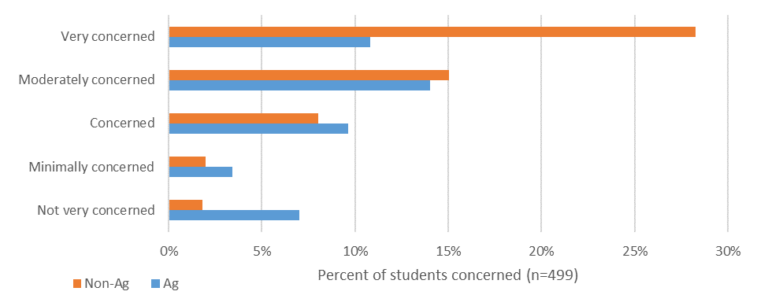
With most students identifying they had some level of concern about climate change, Chloe sought to determine whether students were willing to purchase GM products if they sequestered more carbon than non-GM products. But first, she needed to determine if students thought GM foods were safe and whether students make an effort to avoid purchasing GM food products. Very few students felt that GM foods were unsafe to consume, and over 60% of all responses indicated to some degree that GM foods were safe to consume. The Non-Ag students showed a high response of indifferent, suggesting they either didn’t feel either way or that they possibly were uncertain. Since students, for the most part, showed a positive attitude towards GM safety, Chloe inquired about the purchase of non-GM products over GM when available at a grocery store, to determine the priority of GM vs. non-GM food for the student panel. From this sample, nearly 9% of responses were not applicable, as they were not grocery purchases, however, of the remaining sample, students said they would not purchase non-GM over a GM product. This suggests that while a student’s perception of GM foods safety varied, both the Ag and Non-Ag students did not have a preference or an avoidance of GM foods.
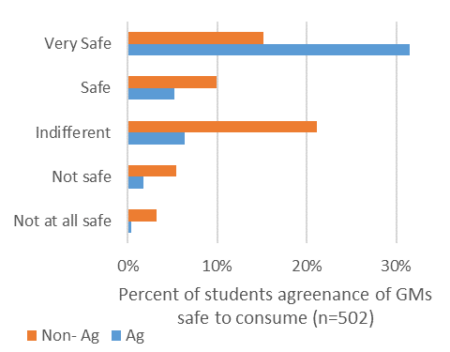

As students were generally willing to purchase GM foods and did not strongly feel that GM food was unsafe, Chloe was not surprised to see that students were in support of GM that sequestered more carbon than non-GM products. Shown in Figure 4, there is little difference in the total sample for those that chose ‘Yes’ or ‘No’, however, those who remained ‘Neutral’ was the difference of 65 Ag students and 103 Non-Ag, equalling one-third of the total sample responding neutrally. This could suggest again either generally neutral feelings towards the question, or an uncertainty. Perhaps, for these students, they would require further information about the levels of sequestration, prices, safety, or the commodity at hand to sway their decision one way or the other.
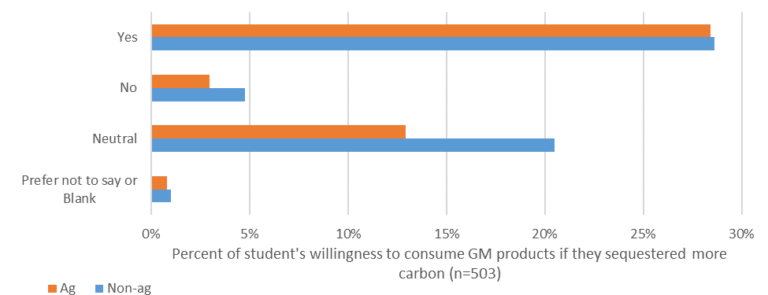
Are students willing to put their money where their mouth is?
Shown in Figure 1, we know students are concerned about climate change, so the next question Chloe had was how willing students would be to pay for a solution to improve our climate change issue? Given the option of how much more would students be willing to pay for GM products labelled with higher carbon sequestrating attributes, student responses varied, with over 50% willing to pay more. When looking at responses between student groups, their willingness to purchase and just by how much, 18% of all students were unwilling to pay more and 24% were indifferent. Non-Ag student willingness to pay peaked at 3-5% (Figure 5) and 58% of the Non-Ag students were willing to pay more than 0%. Under further analysis, 14% of Ag students who were willing to consume a GM sequestering solution were not willing to pay more than 0% for the solution. Whereas, only 5% of Non-Ag student were unwilling to pay more who were willing to consume the GM product.
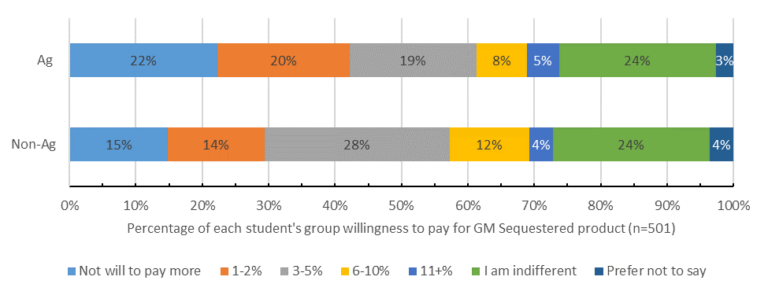
Future looks positive for mitigating of climate change
Students that are supportive of climate change mitigation are also supportive of GM plants that sequester more carbon. When it comes to students’ concern about climate change, the Ag students were still concerned, but to a lesser extent than their peers from other colleges. Of the several hundred students surveyed, Chloe was curious if there would be a difference amongst the willingness of Ag students and their peers to support GM carbon sequestering products and their willingness to pay more for such a solution. However, there was very little difference between the two groups. The majority indicated that they would consume and pay more for positively labelled foods that have been genetically modified to sequester more carbon.
This gives us hope that no matter your connection to agriculture or background, for the most part, our young minds have a positive and open mind when it comes to adopting the solution to help curb our climate change impacts.
[1] Check out one of my previous SAIFood blogs, which discusses the potential for plants to be genetically modified to sequester greater amounts of carbon.
A little about Chloe

Chloe Montreuil grew up on a grain farm near Rosetown, Sk. where she found her love for agriculture. She enrolled in the Agronomy program at the University of Saskatchewan in 2016 and recently finished her degree in the spring of 2020. Chloe is now a new employee of CropPro Consulting (Elbow). She enjoys spending her free time with her family and friends and boating on Lake Diefenbaker.
Congrats Chloe on your B. Ag. & best of luck in your endeavours. We will be keeping an eye out for you, as you have a bright and successful career ahead of you!
Stuart & Savannah


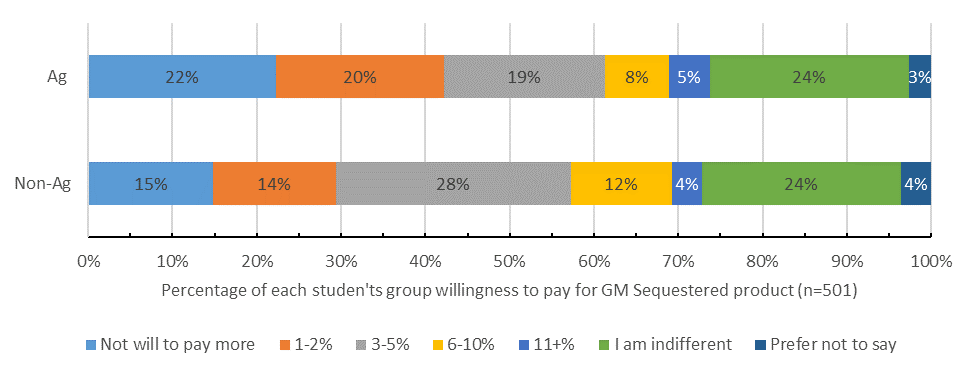
Pingback: Stuart Smyth’s agrichemical industry ties and funding - U.S. Right to Know